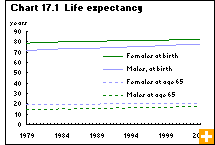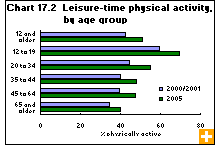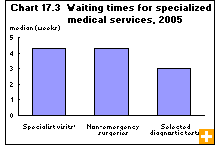Common menu bar links
Health
Archived Content
Information identified as archived is provided for reference, research or recordkeeping purposes. It is not subject to the Government of Canada Web Standards and has not been altered or updated since it was archived. Please contact us to request a format other than those available.
Governments spent $99.0 billion on health services in 2006, up from $44.8 billion in 1991. Most public spending on health services pays for hospitals, drugs and physicians.
The health of Canadians has improved substantially in the last 100 years. Death rates have declined, life expectancy has climbed, many infectious diseases have been virtually eradicated and medical techniques have advanced. In recent surveys, 60% of Canadians said they were in very good or excellent health.
Proportionally more Canadians than in the past have adopted healthy lifestyles, such as exercising and not smoking. Canadians generally also enjoy better socio-economic conditions—such as higher incomes and higher levels of education—that promote better overall health.
Health status
Life expectancy at birth in Canada was 80.2 years in 2004, compared with 77.8 years in 1991. A girl born in 2004 can expect to live 82.6 years; a boy can expect to live 77.8 years. From 1979 to 2004, life expectancy rose 6.4 years for men and 3.8 years for women.
Most Canadians consider themselves to be in good health. In 2005, people aged 20 to 34 had the most positive opinion: 70% rated their health as excellent or very good. The higher their age, the less positive Canadians are about their health. Only 40% of people aged 65 and older regarded their health as good or excellent in 2005.
In the last quarter-century, the leading causes of death in Canada have been diseases of the circulatory system and cancer. Both are more prevalent in an aging population. In 2003, these causes combined were responsible for 6 of every 10 deaths.
Many Canadians today live with chronic health problems, such as high blood pressure and cardiovascular disease. Asthma, diabetes and obesity are among the leading chronic conditions that threaten the health and well-being of a growing number of Canadians. Moreover, as the population ages, other chronic diseases are affecting more people, especially the elderly.
Healthy behaviours, better health
Behaviours such as regular exercise, good eating habits and not smoking are associated with better health. From 2001 to 2005, the proportion of Canadians aged 12 and older who were active or moderately active during their free time increased. In 2005, 51% of Canadians were active or moderately active during their free time, compared with 43% in 2000/2001. People aged 12 to 19 are the most active.
At the same time, the proportion of people who smoke daily declined. In 2005, 22% of Canadians aged 12 and older smoked, down from 26% in 2000/2001. The sharpest drop in smoking rates is among those aged 12 to 17.
Many Canadians do not have a balanced diet, according to the Canadian Community Health Survey. In 2004, 7 out of 10 children aged 4 to 8 were not eating the minimum number of fruit and vegetable servings recommended in Canada’s Food Guide.
For one out of four Canadians aged 31 to 50, fat accounted for more than 35% of their total calories.
On the bright side, average daily calories eaten have increased little in the last three decades, and total fat consumed has declined from 40% of Canadians’ daily calories to 31%.
Access to health services
Although access to health care is guaranteed under the Canada Health Act, some Canadians have difficulty finding a physician—13.6% of the adult population, or 3.5 million Canadians, did not have a regular family doctor in 2005, down slightly from 13.7% in 2003.
A total of 2.8 million people aged 15 and older saw a specialist in 2005, and 19% who needed a specialist’s services had trouble getting access. Long wait times remained the main obstacle. Median wait times for all specialist services varied from three to four weeks depending on the type; the figures were similar in 2003. In 2005, the proportion of Canadians who waited more than three months ranged from 10% for diagnostic tests to 19% for non-emergency surgery.
Progress on wait times has varied by province for certain specialist services. For example, median wait times for non-emergency surgery have been halved in Quebec, dropping from nearly nine weeks in 2003 to four weeks in 2005. In Newfoundland and Labrador, however, median wait times for diagnostic tests have doubled, from two weeks to four weeks; in British Columbia, they increased from two weeks to three weeks.
Patients’ perceptions of wait times were essentially unchanged from 2003 to 2005. Although 70% to 80% of patients consider wait times acceptable, some feel their wait times are unacceptable and have a negative effect on their lives.
The main negative effects that people report are anxiety, stress and worry for themselves, their friends and relatives. Some report they suffer pain and have trouble performing daily activities while they wait.





